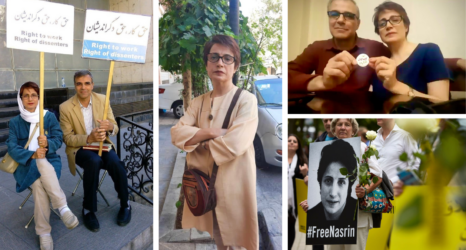In this tumultuous political era, the anonymous, feminist British street artist Bambi is not sitting quiet.
With work that focuses on a plethora of social issues, including modern female identity—specifically in relation to pervasive patriarchal culture—Bambi, known in some circles as the “female Banksy,” never loses sight of her goal to insight social and political change through her art.
Bambi has sparked controversy throughout England and the U.S. with her pieces, which address the disturbing realities of police brutality, Islamophobia and the Trump administration’s attacks on the most marginalized. She has even been pursued criminally, begging the question of where our priorities lie as a society. When there is more of an effort made to reprimand artists bringing injustices to light than there is to actually address and fight the injustices at hand, it becomes crystal clear that we need street artists like Bambi more than ever.
Ms. spoke with Bambi to discuss her role as an artist and how she is navigating the political climate—and boldly embracing the power of art to create change.
How did you first become involved in street art?
It started with spraying the walls of the flat in London where I grew up, with my dad’s car spray. My family were obviously not too pleased with this, so I decided to move my activities outside. My first street art piece was a collection of stars made with a hand cut stencil that I sprayed on a Rolls Royce near our estate. Luckily, I never actually got caught.
I did study art at Central St. Martins but hated how pretentious it all was. But at the same time, being exposed to that environment and learning gave me that gift—of knowing what didn’t inspire me—as much as what did. But I’m more at home on the street and it’s my favourite place to create and show work.
What would you say is your biggest goal as an artist?
Through my art I try to encourage consideration of the world, of the issues facing it and hope to inspire change. I think street art is an accessible art form that can be viewed by everyone, those people who would never consider going to an art gallery, or think they would not be inspired by traditional “art.” But my biggest goal is to have an influence on political and social change. I think that if even just one of my pieces reaches one other person and gets them to think about what’s happening in our world, and hopefully inspire them to change their ways, or work with those around them, then that’s what success looks like to me.
Has your work always been as politically charged as it currently is? If not, what was a defining moment for you that made you switch your focus to a more political cause?
I’ve always had some political motivation in my work, though the real common thread is humour. I think the way to get people’s attention and make them think about issues, be they social and environmental, is to try to be humorous—without offending anyone in the process, if that’s possible. Having said that, I go by the belief that an extreme reaction is better than no reaction.
I think for me, as for many of us, the events of the past year or so have really shaped and refocused me, particularly politically. Trump’s presidency, and Brexit here in the UK, are nation and world changing events—not in a good way in my opinion. But what’s true is they give you phenomenal source material, such as UK Prime Minister Theresa May and Donald Trump dancing in Lie Lie Land. The continued extremes in our global political situation inspire and worry me in equal measure. I have a good few pieces planned on recent political events.
Who and what inspires you?
I love Peter Doig and Cindy Sherman, and Lucien Freud and Francis Bacon have also influenced my work. The passion communicated through their work is astounding. Passion for comment, for change is fundamental to what I do. I’m driven to communicate in the same way.
Francis Bacon in particular inspires me. He was at St. Martin’s a lot when I was there, often buying our canvasses at the same time at Russell and Chapple, and with the odd conversation. These great British painters who forged their own way, whilst retaining that British eccentricity, stubbornness, grit, whatever you call it, are fundamental to British art. I would argue that the greatest street artists of our time are this important.
There has been a lot of talk recently about freedom of speech and censorship. How do you navigate the fine line between articulating your message and not watering it down—or on the opposite side of the spectrum, not representing it “too harshly?”
I’ve always had social comment in my work. My Don’t Shoot piece, that’s still on a wall in Shoreditch in East London, is about the shooting of Michael Brown, and was so controversial that the CID police tried to locate my fingerprints from the wall. I assume they wanted to charge me with inciting a riot. Fortunately, I wear surgical gloves when I’m painting……
What is something you wish more people knew about the work that you do?
Probably that it’s a huge amount of work! I think some folks might think street art is a bit of random graffiti, but it’s actually pretty time consuming. I hand cut all my stencils and hand draw all my artwork, and a street piece can take weeks or even months to prepare. My art is never computer generated. Also, I believe that street art holds as much importance as any other art. The experience that street art offers the viewer is as vital as the experience a viewer of say, Picasso, experiences when viewing that work.





